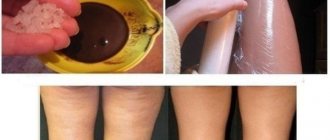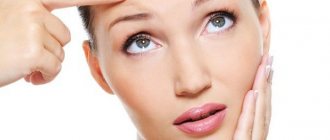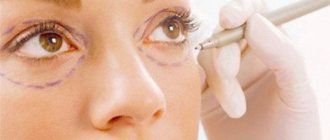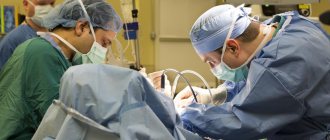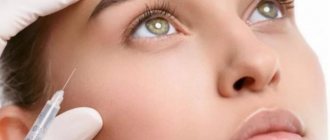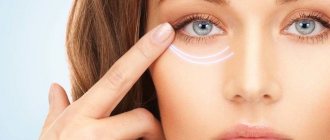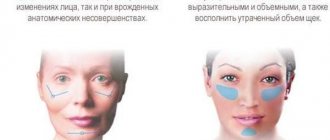Why do bags form under the eyes?
The eyeball is naturally separated from the skin and muscles by layers of fat, which are most pronounced in the infraorbital area. There are also additional fat deposits in the zygomatic area and the area of the tear trough. If the tissues weaken, lose elasticity, become thinner, the intraorbital membrane experiences increased stress. The fat pads that they hold begin to move forward, and pouches form in the lower eyelid area. They put pressure on the blood and lymphatic capillaries, fluid retention occurs, and dark circles with swelling occur.
A similar process occurs in the area of the upper eyelid. It hangs over, causing discomfort, causing wrinkling of the forehead and the development of wrinkles.
Is it necessary to remove hernias on the eyelids?
Most people can live comfortably with this feature without experiencing any inconvenience other than aesthetic ones.
But it is necessary to take into account that hernia formations can increase. And then it is possible that more serious problems with vision may arise. After all, a hernia puts pressure on the tissues and blood vessels of the eyes, and this contributes to the deterioration of their blood supply and nutrition. The developing defect makes the occurrence of local infections more likely. It causes the skin, muscles and ligaments to weaken faster. This means that the owner of hernia formations under the eyelids will look older than his age. And when the need arises to get rid of the problem for medical reasons, the most traumatic method of intervention will be acceptable for correction.
Causes of bags, swelling
If we put all the factors together, we can identify the key reasons for the development of the problem. You need to know them when determining how to remove bags under the eyes.
The tissues sag due to a lack of collagen and its age-related degeneration. In addition, heredity, sleep deficiency, incorrect choice of pillow, resting posture and bad habits play a significant role. Eating large amounts of salty, sweet and very spicy foods and alcohol have a negative effect.
In addition, some diseases can cause swelling and bags under the eyes. These include kidney damage, heart problems that cause tissue swelling, damage to the lymphatic system and some chronic infections. Dark circles and puffiness under the eyes can be caused by allergies. To diagnose these pathologies, you need to consult a doctor and perform blood, urine, ECG and ultrasound tests of the abdominal organs.
Sign up for a free appointment:
Supraperiosteal removal only, endoscopy will not help
— They say that endoscopic face lifting also allows you to get rid of paint bags on the cheekbones/cheeks...
The main problem with endoscopic lifting is that the painting bag, which is of concern to the patient who wants to rejuvenate the midface, is not removed, but is moved to a higher position. This is because lifting the middle zone through the incisions in the mouth and temples will simply not remove the paint bag. Above the area of the paint sac is the periosteum. If you pull on the periosteum, the bag will not go away. In other words, facial endoscopy involves actions in the subperiosteal zone, and this, as a rule, is ineffective. The area (paint bag) simply shifts and natural subsidence occurs over time. Relapse is about 80%
.
The only effective way to remove the paint bag is supraceriosteal removal, or, in other words, performing a supraceriosteal check-lift.
Lower blepharoplasty is not
solves the problem of the middle zone and paint bags
- Interesting. Is isolated lower eyelid surgery capable of rejuvenating the cheek area?
No, and not even all plastic surgeons understand this. The surgeon, having performed only lower eyelid surgery, underestimated the condition of the patient’s midface, contrary to expectations
, gets a result that is worse than if he had done nothing at all.
Any eyelid surgery, no matter how well it is performed, does not affect the malar area. Only the area up to the orbital rim is affected. At the same time, neither lipofilling nor redistribution of the hernia will in any way affect the malar zone. Therefore, lower blepharoplasty does not solve the problem of the middle zone. Moreover, if the hernia was transferred without canthopexy, in addition to temporary subversion, the patient may experience the effect of “sunken” eyes. When the hernia is removed, the edge of the orbit of the eye comes to the fore. Often the hernia masks this edge.
Accordingly, if we remove it, we will only emphasize the black circle in the eye area. An interesting fact is that check-lifting was first carried out at the beginning of the twentieth century. It was invented by a French surgeon. Not without difficulties. Surgeons were not able to touch deeper areas (although some surgeons still perform the cheek lift superficially as well). The operation consisted of many small nuances. Good knowledge, first of all, of the anatomy of the paraorbital zone was required. There was a high risk of nerve injury. Later, surgeons tried to perform the operation, but due to numerous difficulties they found it ineffective.
Pseudo-painters and true painters
- Let's talk about true and pseudo painting bags...
There are pseudo-painters and true painters.
Pseudomalar ptosis is a natural ptosis that can be easily corrected. True painters are determined by the facial structure of a given patient and are not tied to age. They tend to occur in patients with oily skin. True painters are very difficult to remove without direct exposure to them.
The malar zone can be located closer to the temporal zone, or to the auricle. If you draw an imaginary line from the corner of the eye to the corner of the mouth, then most often the inner portion requires correction. Actually, any check-lifting is aimed at lifting this area: from an imaginary line drawn inward. The paint bag is located on the outside of the imaginary line.
Usually it does not bother you because it “merges” with age-related changes that occur in the lower third of the face and on the face as a whole. The bulk of the painting bag is corrected through SMAS lifting and facelift. The problem is more complex than it seems at first glance.
— What kind of manipulations does performing a supraceriosteal check-lift involve?
A huge range of work is being carried out in this area. The buccal area is raised to a higher position by working the muscle. This allows you to work with the painter. Myopexy
(tightening the orbicularis oculi muscle) is an integral part of any operation on the middle zone.
If done incorrectly
, we end up with eversion of the eyelids, which is extremely difficult to correct. I had to help patients with this problem. It was no longer about beauty, but about restoring the function of the eye. When eversion occurs, the shape of the eye is deformed, dryness appears, this can lead to ophthalmological complications, including a significant decrease in vision. Moreover, after aggressive operations, it is difficult to restore the orbicularis oculi muscle and the condition of the canthal ligament since it is deformed by scars.
In our clinic, it will take one hour to do the middle zone and upper eyelids. This is a well-developed operation that includes supraceriosteal, subperiosteal, subcutaneous effects and work with the muscle.
— Check-lifting is positioned as an outpatient operation, is that true?
Many, both surgeons and patients, treat even transconjunctival blepharoplasty very easily. The operation, indeed, lasts 15-20 minutes, but in the end the patient may not get the result he expected. It is necessary to take into account the condition of the skin, muscles, as well as the condition of the hernia - the possibility and impossibility of its movement. So-called “office” surgery can backfire on the patient. A check lift cannot be considered an outpatient procedure if approached properly, although the rehabilitation is comparable to regular lower eyelid surgery.
Removing bags under the eyes without surgery
The main problem of many patients is morning bags under the eyes. Tea compresses help eliminate them. Due to the influence of tannins and caffeine, they constrict blood vessels and increase the removal of fluid from tissues. Compresses with chamomile tea help remove signs of fatigue and eye irritation.
Cold spoons help to quickly cope with the problem. They eliminate swelling and redness by constricting blood vessels. Another quick and easy way to remove morning swelling is a cucumber mask. Two cool circles of cucumber placed on the eyes stimulate the capillaries to drain excess fluid.
You can wipe the skin around the eyes with cold milk, and then apply patches soaked in cold milk to the area under the eyes.
These same tips can be used regularly to eliminate dark circles, puffiness and bags under the eyes at home.
Massage, which is carried out according to strictly defined rules, can help combat the problem. You need to apply a little eye cream to the periorbital area, place your index fingers in the bridge of the nose, move them along the eyebrows, and then move down along the edges of the eye sockets, making light patting movements.
What else can you do to reduce the bags under your eyes? Use cosmetics. Together with a cosmetologist during a consultation, you need to select products that help reduce puffiness and dark circles.
Prevention of dark circles around the eyes.
Along with the above methods, it is worth paying attention to ways to prevent the appearance of dark circles:
- proper and balanced nutrition (reducing salt intake, increasing the amount of vegetables and fruits in the diet);
- proper daily routine and proper sleep (walks in the fresh air, sleep for at least 8 hours, reducing time spent on the computer and other popular gadgets);
- organizing a healthy lifestyle (quitting smoking and alcoholic beverages, minimizing stressful situations);
- compliance with the drinking regime;
- performing gymnastics for the eyes.
Gymnastics for the eyes should be given 5 minutes a day; it improves lymphatic and venous drainage. Gymnastic exercises are as follows:
- Roll your eyes for 1 minute;
- with your eyes closed, lift them up 8 times and then lower them down;
- rapid blinking for 30 seconds;
- With your eyes open, draw the letter “V” with them.
To summarize, we can conclude that cosmetics and masks, when solving the problem of bruises, provide only a temporary effect, so they are recommended to be used if the problem is caused by a temporary phenomenon - overwork, violation of the work and rest schedule, stressful situation. In all other cases, it is worth resorting to modern cosmetology methods.
An aesthetic defect in the form of bruises under the eyes is an unpleasant, but completely solvable problem.
Cosmetology procedures
Modern cosmetology offers various methods for correcting bags in the periorbital area.
- Mesotherapy is the introduction through microinjections of a vitamin-mineral cocktail with biologically active substances, hyaluronic acid. The composition is selected individually, after the administration of the drugs, metabolism in cells is stimulated, blood vessels are toned, and the skin is smoothed. This eliminates puffiness and bags.
- The laser removal procedure – fractional thermolysis, due to tissue microperforations, tightens and renews the skin, reducing the severity of the problem. In addition, the laser stimulates the synthesis of collagen and elastin fibers.
- RF lifting (skin tightening due to radiofrequency effects). Warming up the tissues helps in their compaction and contraction, stimulating metabolic processes, which enhances fluid drainage.
- The introduction of fillers helps to remove dark circles, and less often, to eliminate bags, especially if it is associated with gravitational ptosis. The choice of filler is important so as not to increase swelling. Sometimes lipolytics can be used, but this requires special indications.
- Botox or Dysport injections will not be effective in the fight against puffiness, but they can reduce wrinkles and relax muscles, indirectly helping to solve the problem.
- If all the measures listed above do not help, the problem progresses, the eye bags are very pronounced, there is ptosis of the eyelids, surgery to remove bags under the eyes is indicated. Various oculoplastic techniques will be performed; modern surgeons prefer to perform interventions in the least traumatic ways. This can be the removal or reposition of fat bags, the fetgrafting method (moving fat cells to the desired areas), browlifting or the pinch method, canthopexy.
Out Of Label
Some cosmetologists, having attended plastic surgeons' master classes, for some reason decided that Diprospan injections into paint bags are a panacea that no one knows about, and only they have discovered sacred knowledge.
Comments Nino Konstantinovna Kobaladze, head of the plastic surgery department at MedClinic (St. Petersburg), member of the European Medical Laser Association, member of the International Association of Laser Medicine and Surgery, member of the American Academy of Anti-Aging Medicine:
Why can’t a cosmetologist inject Diprospan into paint bags? This is a very complex, serious drug that can cause atrophy of subcutaneous fat, and its incorrect administration can lead to unpleasant and visible complications. "Diprospan" is usually administered by surgeons in the treatment of complex subcutaneous scars with contractures and keloid scars. It is very important to feel the tissue and understand exactly where the needle is. The dosage, dilution and indications for this drug are also important.
Indications
- Excess tissue on the eyelids, which makes the face look tired.
- Folds of skin on the upper eyelids that hang over the eyes.
- Drooping skin under the eyes, so-called bags.
- Pathological fatty deposits on the eyelids.
- Drooping of the corners of the eyes.
- An inversion of the eyelid, leading to mechanical irritation of the eyeball by constant friction of the eyelashes, lacrimation and even the formation of erosions on the cornea.
- Protrusion of the eyeball (exophthalmos), in which the eyelids lose their limiting function.
